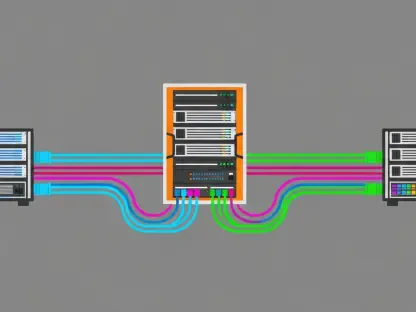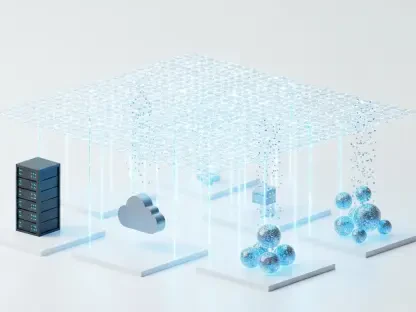In the rapidly evolving field of computing technology, two models have emerged as pivotal players: edge computing and cloud computing. Both offer unique advantages and cater to different needs, making the choice between them a critical decision for businesses and individuals alike. This article delves into the definitions, mechanisms, benefits, drawbacks, and use cases of each model, providing a comprehensive guide to help you determine which one suits your requirements best.
Understanding Cloud Computing
Definition and Mechanism
Cloud computing is a model that provides access to computing resources such as servers, storage, and software over a network, typically the internet. This model allows users to leverage powerful infrastructure without substantial upfront investments. The infrastructure is hosted by third-party cloud service providers in data centers, enabling users to access resources on a pay-as-you-go basis. By distributing resources across multiple servers, cloud computing ensures resilience, scalability, and efficient resource management, making it an indispensable tool for modern enterprises.
Cloud service providers offer a variety of services, including Infrastructure as a Service (IaaS), Platform as a Service (PaaS), and Software as a Service (SaaS). Each of these services caters to different needs, from basic storage and networking to sophisticated development platforms and fully managed applications. By utilizing these services, organizations can avoid the complexities of managing their own physical servers and infrastructure, freeing up resources to focus on strategic initiatives. The combination of accessibility, cost-efficiency, and flexibility makes cloud computing an attractive option for businesses of all sizes.
Benefits of Cloud Computing
Cloud computing offers several advantages, including cost-effectiveness, scalability, and reliability. Users benefit from improved accessibility, enhanced collaboration, and the ability to innovate without the need for significant infrastructural investments. The pay-as-you-go pricing model ensures that users only pay for what they use, making it a flexible and economical option. Additionally, cloud computing fosters seamless collaboration by enabling employees to access the same resources and tools, regardless of their geographical location.
Cloud computing also offers built-in redundancy, ensuring that data is automatically backed up across multiple servers. In the event of a hardware failure, services can be quickly restored, minimizing downtime and ensuring business continuity. Furthermore, cloud providers continuously invest in security measures, including encryption and access controls, to protect data from cyber threats. These comprehensive security features provide organizations with peace of mind, knowing that their sensitive information is safeguarded in a secure environment.
Drawbacks of Cloud Computing
Despite its many benefits, cloud computing has some downsides. Users have limited control over the underlying hardware, and the reliance on internet connectivity can pose challenges. Additionally, the exposure to the internet increases vulnerability to cyber threats, and managing costs can be complex due to the varied components contributing to overall spending. While cloud providers implement robust security measures, the risk of data breaches cannot be entirely eliminated, necessitating a shared responsibility model between providers and users.
Bandwidth limitations can also affect the performance of cloud-based applications, particularly in regions with poor internet infrastructure. Businesses may experience latency issues, affecting the responsiveness of critical applications. Furthermore, the pay-as-you-go pricing model, while flexible, can lead to unexpected costs if resource usage is not carefully monitored. Organizations need to implement effective cost management strategies to avoid budget overruns and ensure that their cloud investments deliver the expected return on investment.
Exploring Edge Computing
Definition and Mechanism
Edge computing focuses on processing data closer to the source or end-user to achieve faster data transfers and real-time processing. This model minimizes latency and enhances performance by hosting workloads on local or proximal computing resources, such as edge devices or nearby data centers, rather than relying solely on centralized cloud servers. By bringing computation closer to the data source, edge computing significantly reduces the time it takes to process and analyze data, leading to quicker insights and more responsive applications.
Edge computing is particularly beneficial for Internet of Things (IoT) devices, which generate vast amounts of data that need to be processed in real-time. Instead of sending all this data to a distant cloud server for analysis, edge computing enables immediate processing at the source, reducing the load on the network and ensuring that critical decisions can be made without delay. This decentralized approach to computing enhances the efficiency and reliability of IoT applications, making it an essential component of modern smart systems.
Benefits of Edge Computing
Edge computing offers lower latency, real-time data processing, and reduced attack surfaces. By processing data locally, edge computing minimizes the time required to transmit data to a centralized server and back, thereby enabling faster response times for critical applications. This real-time processing capability is particularly advantageous for applications such as autonomous vehicles, industrial automation, and remote healthcare, where immediate data analysis is crucial for safety and efficiency.
The decentralized nature of edge computing also reduces the attack surface for cyber threats, as data is processed and stored across multiple edge devices rather than a central location. This distribution of data enhances security by limiting the potential impact of a single breach. Additionally, edge computing enables cost savings by reducing the need for extensive internet connectivity. By processing data locally, organizations can lower their bandwidth usage and reduce costs associated with data transmission to centralized cloud servers.
Drawbacks of Edge Computing
However, edge computing also has its challenges. It offers limited scalability compared to cloud computing and can face security issues with poorly secured devices like IoT devices. While edge computing reduces latency and enhances performance, it is not as easily scalable as cloud computing, which can dynamically allocate resources based on demand. This limitation can be a significant drawback for organizations that require rapid scalability to accommodate growing workloads or fluctuating demand.
Edge computing devices are often located in less controlled environments, making them susceptible to physical tampering and security breaches. Ensuring the security of these devices requires robust encryption, access controls, and regular updates to address vulnerabilities. Furthermore, the need for significant storage capacity to support local data processing can be a limiting factor for some applications. Organizations must invest in sufficient storage infrastructure to handle the data generated by edge devices, which can be a costly undertaking.
Integration and Mutual Benefits
The Edge-Cloud Continuum
As the demand for real-time analytics and low-latency data transfers grows, edge computing and cloud computing are becoming increasingly interconnected. An edge-cloud continuum framework is emerging, where workloads are distributed between the edge and cloud based on their specific requirements. Low-latency tasks are handled by the edge, while high-demand processing is offloaded to the cloud for enhanced efficiency. This hybrid approach leverages the strengths of both models to create a seamless and adaptable computing environment.
By integrating edge and cloud computing, organizations can achieve a balance between immediate data processing needs and extensive computational demands. This synergy allows for the efficient handling of diverse workloads, from real-time analytics and monitoring to large-scale data storage and processing. The edge-cloud continuum framework ensures that each task is managed by the most suitable resources, optimizing performance and cost-efficiency across the entire computing infrastructure.
Performance Optimization
By combining edge and cloud computing, organizations can optimize performance by handling latency-sensitive tasks at the edge and offloading heavy processing to the cloud. This hybrid approach leverages the strengths of both models, ensuring a balanced and efficient computing environment. For instance, in a manufacturing setting, edge computing can be used to monitor and control machinery in real-time, while the cloud can handle more complex analytics and predictive maintenance.
This division of labor not only enhances performance but also improves the reliability and resilience of the overall system. In the event of a network disruption or cloud service outage, edge computing ensures that critical operations continue without interruption. Conversely, the cloud provides the necessary computational power and storage capacity to process and analyze large datasets, supporting long-term strategic decision-making. The combination of edge and cloud computing creates a robust and adaptive computing environment capable of meeting the diverse needs of modern organizations.
Cost Efficiency and Security
Edge computing can achieve significant cost savings by reducing dependence on wide-ranging broadband connectivity, while cloud computing ensures cost-effective scalability. By processing data locally, edge computing minimizes the need for extensive data transmission, lowering bandwidth costs and reducing the overall burden on network infrastructure. This cost efficiency is particularly beneficial for organizations with large numbers of IoT devices or remote locations with limited internet connectivity.
Additionally, edge computing offers an enhanced security framework by minimizing data exposure. By keeping data processing and storage closer to the source, the risk of data breaches and cyber-attacks is reduced. At the same time, cloud computing’s redundancy and robust security measures ensure data reliability and accessibility even during failures. By combining the security advantages of edge computing with the resilience of cloud computing, organizations can create a secure and reliable computing environment that protects sensitive information while maintaining high levels of performance and availability.
Use Cases and Industry Applications
Cloud Computing Use Cases
Cloud computing is ideal for global collaborative efforts, large-scale data backup, and applications requiring extensive processing power. It supports a wide range of industries, from finance to healthcare, by providing scalable and reliable infrastructure for various applications. For example, in the finance industry, cloud computing enables real-time trading, risk management, and regulatory compliance by providing powerful analytics and data storage capabilities.
In healthcare, cloud computing facilitates the storage and analysis of vast amounts of medical data, supporting research, diagnostics, and patient care. Cloud-based electronic health records (EHRs) enable seamless sharing of patient information across different healthcare providers, improving the quality and continuity of care. Additionally, cloud computing supports telemedicine, allowing healthcare professionals to conduct remote consultations and monitor patients’ health in real-time, enhancing access to medical services and reducing the need for in-person visits.
Edge Computing Use Cases
Edge computing is particularly advantageous for real-time data processing in smart devices, local security applications, and scenarios where low latency is critical. Industries such as manufacturing, transportation, and retail benefit from edge computing by enabling immediate data analysis and decision-making. In manufacturing, edge computing can be used to monitor and control production lines, ensuring that machinery operates efficiently and detecting issues before they escalate.
In the transportation industry, edge computing supports real-time traffic management, autonomous vehicles, and fleet tracking by processing data locally and providing immediate feedback. This enhances the safety and efficiency of transportation systems, reducing delays and improving route optimization. Retailers can leverage edge computing to analyze customer behavior in real-time, enabling personalized shopping experiences and efficient inventory management. By processing data at the edge, retailers can quickly respond to changing customer demands and improve the overall shopping experience.
Hybrid Approach in Practice
Many organizations are adopting a hybrid approach, combining edge and cloud computing to fulfill a broad spectrum of computing requirements. This approach allows for immediate data processing at the edge while leveraging the cloud for complex data computations, creating a versatile and adaptive computing framework. For example, smart cities can utilize edge computing for real-time monitoring of traffic, air quality, and public safety, while using cloud computing for long-term data analysis and planning.
In the energy sector, edge computing can be used to monitor and control smart grids, ensuring efficient energy distribution and reducing outages. The cloud can then analyze the data collected from these grids to optimize energy usage and support the integration of renewable energy sources. By combining the strengths of edge and cloud computing, organizations can create a flexible and resilient computing environment that meets the demands of modern applications and drives innovation across various industries.
Future Trends and Developments
Evolving Technologies
The integration of edge and cloud computing is driving innovation in various fields, from artificial intelligence to the Internet of Things (IoT). As technology continues to evolve, the synergy between edge and cloud computing will likely lead to more advanced and efficient computing solutions. For instance, the development of 5G networks will enhance the capabilities of edge computing by providing faster and more reliable connectivity, enabling real-time data processing for a wide range of applications.
Artificial intelligence and machine learning algorithms can be deployed at the edge to analyze data in real-time, making intelligent decisions and automating processes. This will enable more efficient and responsive systems, from autonomous vehicles to smart homes and cities. The combination of edge and cloud computing will also facilitate the growth of IoT ecosystems, allowing for seamless integration and management of connected devices. As these technologies advance, the edge-cloud continuum will become increasingly significant in shaping the future of computing.
Industry Consensus
Industry experts agree that neither edge computing nor cloud computing can fully replace the other. Instead, they complement each other, creating more robust and adaptive computing environments. The trend towards hybrid approaches reflects the growing recognition of the benefits of integrating both models. Organizations that adopt a hybrid strategy can leverage the strengths of each model to address specific use cases, optimizing performance, cost-efficiency, and security.
By combining edge and cloud computing, organizations can create a flexible and resilient computing infrastructure that can adapt to changing business needs and technological advancements. This hybrid approach will enable organizations to stay competitive in a rapidly evolving marketplace, driving innovation and improving operational efficiency. Industry leaders and technology providers are investing in solutions that facilitate the seamless integration of edge and cloud computing, ensuring that businesses can harness the full potential of both models.
Preparing for the Future
In the swiftly changing world of computing technology, two key models have become major players: edge computing and cloud computing. Each has its own set of advantages and specifically addresses different needs. Deciding between these two models is crucial for both businesses and individuals. This discussion explores the definitions, mechanisms, benefits, drawbacks, and uses of each model.
Edge computing involves processing data close to its source, reducing latency and improving speed, which is especially critical for applications requiring real-time data, such as autonomous vehicles and smart grids. Cloud computing, on the other hand, leverages centralized data centers to store and manage data, offering scalable resources and cost-efficiency. It’s particularly beneficial for businesses with fluctuating demands and less need for real-time processing.
While edge computing offers faster data handling and reduced bandwidth usage, it can be limited by hardware constraints and security concerns at the data source. Conversely, cloud computing provides easier management and greater data access but can suffer from latency and requires a dependable internet connection.
Understanding the distinct strengths and limitations of edge and cloud computing allows organizations to make informed decisions about which to implement based on their specific requirements, objectives, and constraints. This guide aims to help determine which model best aligns with your needs.









